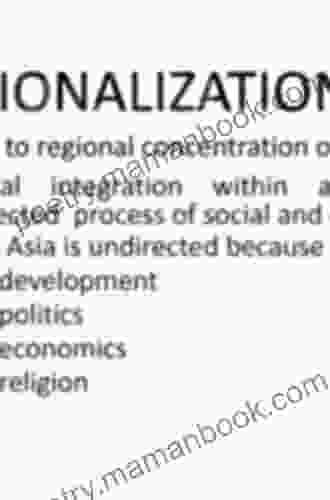From Regionalization to Regionalism: A Comprehensive Analysis of the Evolution and Impact of Regional Cooperation

4.5 out of 5
| Language | : | English |
| File size | : | 8522 KB |
| Text-to-Speech | : | Enabled |
| Enhanced typesetting | : | Enabled |
| Word Wise | : | Enabled |
| Print length | : | 209 pages |
| Screen Reader | : | Supported |
In an increasingly interconnected world, regional cooperation has emerged as a key driver of globalization and international relations. Regionalization, the process of intensifying economic, political, and cultural ties among neighboring countries, has given way to regionalism, which involves the creation of formal institutions and mechanisms for regional cooperation.
This article provides a comprehensive analysis of the evolution and impact of regional cooperation, from its historical roots to its contemporary manifestations. We will explore the different forms of regional cooperation, the factors driving regionalization and regionalism, and the implications for global governance and international stability.
The Evolution of Regional Cooperation
The origins of regional cooperation can be traced back to ancient times, with the formation of city-states and empires. However, the modern concept of regional cooperation emerged in the 19th century, with the rise of nationalism and the industrial revolution.
The first regional organizations were established in Europe, such as the German Customs Union (1834) and the Latin American Free Trade Association (1960). These organizations were primarily focused on economic integration, with the aim of reducing trade barriers and promoting economic growth.
After the Second World War, regional cooperation expanded rapidly, with the establishment of regional organizations in all parts of the world. These organizations covered a wide range of issues, including economic development, security, and human rights.
Factors Driving Regionalization and Regionalism
There are a number of factors that have driven the growth of regionalization and regionalism in recent decades. These include:
- Globalization: Globalization has led to increased interdependence among countries, which has made regional cooperation more necessary and beneficial.
- Technological advances: Technological advances have made it easier for countries to communicate and cooperate with each other, which has facilitated regionalization.
- Political and economic liberalization: Political and economic liberalization has made it easier for countries to enter into regional agreements.
- Security concerns: Security concerns have also driven regional cooperation, as countries have sought to cooperate to address common threats.
Forms of Regional Cooperation
Regional cooperation can take a variety of forms, including:
- Free trade agreements (FTAs): FTAs are agreements between two or more countries that reduce or eliminate tariffs and other trade barriers.
- Customs unions: Customs unions are FTAs that also include a common external tariff, which means that all member countries charge the same tariffs on imports from non-member countries.
- Common markets: Common markets are customs unions that also allow for the free movement of labor and capital.
- Economic and monetary unions (EMUs): EMUs are common markets that also have a common currency.
- Political unions: Political unions are regional organizations that have a common government and political system.
The Impact of Regional Cooperation
Regional cooperation has had a significant impact on the global economy, politics, and security.
- Economic impact: Regional cooperation has led to increased trade and investment, which has contributed to economic growth and development.
- Political impact: Regional cooperation has helped to promote democracy and stability, by providing a forum for countries to resolve disputes and cooperate on common issues.
- Security impact: Regional cooperation has helped to reduce conflict and promote security, by providing a framework for cooperation on security issues.
Challenges to Regional Cooperation
Despite the many benefits of regional cooperation, there are also a number of challenges that can hinder its progress. These include:
- National sovereignty: Countries are often reluctant to cede sovereignty to regional organizations, which can make it difficult to reach agreements.
- Economic disparities: Economic disparities between countries can make it difficult to create fair and equitable regional agreements.
- Political differences: Political differences can also make it difficult for countries to cooperate, especially on sensitive issues.
The Future of Regional Cooperation
Despite the challenges, regional cooperation is likely to continue to grow in importance in the future. Globalization and technological advances will continue to drive interdependence among countries, which will make regional cooperation more necessary and beneficial.
Regional cooperation is also likely to play a key role in addressing global challenges, such as climate change and terrorism. By working together, countries can pool their resources and expertise to find solutions to these challenges.
Regional cooperation has emerged as a key feature of the global landscape. It has had a significant impact on the global economy, politics, and security. While there are a number of challenges to regional cooperation, it is likely to continue to grow in importance in the future.
By understanding the evolution, factors driving, and impact of regional cooperation, we can better understand the complex dynamics of the global system and the challenges and opportunities that lie ahead.
4.5 out of 5
| Language | : | English |
| File size | : | 8522 KB |
| Text-to-Speech | : | Enabled |
| Enhanced typesetting | : | Enabled |
| Word Wise | : | Enabled |
| Print length | : | 209 pages |
| Screen Reader | : | Supported |
Do you want to contribute by writing guest posts on this blog?
Please contact us and send us a resume of previous articles that you have written.
 Top Book
Top Book Novel
Novel Fiction
Fiction Nonfiction
Nonfiction Literature
Literature Paperback
Paperback Hardcover
Hardcover E-book
E-book Audiobook
Audiobook Bestseller
Bestseller Classic
Classic Mystery
Mystery Thriller
Thriller Romance
Romance Fantasy
Fantasy Science Fiction
Science Fiction Biography
Biography Memoir
Memoir Autobiography
Autobiography Poetry
Poetry Drama
Drama Historical Fiction
Historical Fiction Self-help
Self-help Young Adult
Young Adult Childrens Books
Childrens Books Graphic Novel
Graphic Novel Anthology
Anthology Series
Series Encyclopedia
Encyclopedia Reference
Reference Guidebook
Guidebook Textbook
Textbook Workbook
Workbook Journal
Journal Diary
Diary Manuscript
Manuscript Folio
Folio Pulp Fiction
Pulp Fiction Short Stories
Short Stories Fairy Tales
Fairy Tales Fables
Fables Mythology
Mythology Philosophy
Philosophy Religion
Religion Spirituality
Spirituality Essays
Essays Critique
Critique Commentary
Commentary Glossary
Glossary Bibliography
Bibliography Index
Index Table of Contents
Table of Contents Preface
Preface Introduction
Introduction Foreword
Foreword Afterword
Afterword Appendices
Appendices Annotations
Annotations Footnotes
Footnotes Epilogue
Epilogue Prologue
Prologue Carl Von Clausewitz
Carl Von Clausewitz Barrington Moore
Barrington Moore Lawrence Wray
Lawrence Wray Jo Bryson
Jo Bryson Ted Boone
Ted Boone N E Davenport
N E Davenport Mina S Love
Mina S Love J Robert Kennedy
J Robert Kennedy Simon Monk
Simon Monk Sarah L Carter
Sarah L Carter Heather O Donoghue
Heather O Donoghue Simon Sinek
Simon Sinek Shalini Boland
Shalini Boland John Bradley
John Bradley Dario La Rosa
Dario La Rosa Jeff Stafford
Jeff Stafford K C Kemp
K C Kemp Richard Dobbs
Richard Dobbs Linda Finlay
Linda Finlay Leticia Sala
Leticia Sala
Light bulbAdvertise smarter! Our strategic ad space ensures maximum exposure. Reserve your spot today!

 Orson Scott CardMy Beloved Writer Iniya Chitravel: A Literary Luminary Whose Words Ignite...
Orson Scott CardMy Beloved Writer Iniya Chitravel: A Literary Luminary Whose Words Ignite...
 Anton FosterThe Manifesto Manifesto: Robert Estella's Blueprint for a New Era of Social...
Anton FosterThe Manifesto Manifesto: Robert Estella's Blueprint for a New Era of Social... Leo MitchellFollow ·4.8k
Leo MitchellFollow ·4.8k Jett PowellFollow ·7.1k
Jett PowellFollow ·7.1k Giovanni MitchellFollow ·6.9k
Giovanni MitchellFollow ·6.9k Nathan ReedFollow ·2.1k
Nathan ReedFollow ·2.1k Clark CampbellFollow ·17.8k
Clark CampbellFollow ·17.8k Demetrius CarterFollow ·11.9k
Demetrius CarterFollow ·11.9k Eliot FosterFollow ·19.8k
Eliot FosterFollow ·19.8k Davion PowellFollow ·3.9k
Davion PowellFollow ·3.9k

 Patrick Hayes
Patrick HayesDeath on Stage: Euphemia Martins Mystery 16
Synopsis In the...

 Benji Powell
Benji Powell1001 Best Baking Recipes Of All Time
Baking is a fun and...

 Terry Bell
Terry BellDestined War of the Covens: A Supernatural Saga of Power,...
Welcome to the...

 Mark Twain
Mark TwainBitcoin For Mere Mortals: A Comprehensive Guide for...
Bitcoin is a...

 Dennis Hayes
Dennis HayesThe Best Budget Gaming PC 2024: Build the Ultimate Gaming...
Are you looking to build the best budget...
4.5 out of 5
| Language | : | English |
| File size | : | 8522 KB |
| Text-to-Speech | : | Enabled |
| Enhanced typesetting | : | Enabled |
| Word Wise | : | Enabled |
| Print length | : | 209 pages |
| Screen Reader | : | Supported |










